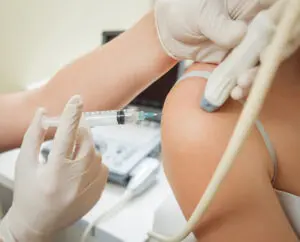What if we told you that you could have an injection into a damaged part of your body, like the shoulder, that would stimulate the growth of healthy new cells as well as promote faster healing? Instead of thinking it’s something from the future, perhaps you should know the reality that is PRP.
What Is PRP?
PRP stands for platelet-rich plasma. Plasma is a part of our blood that contains proteins which help our blood to clot. Those same proteins can also encourage cell growth. Researchers have now been able to separate plasma from the blood to form a concentrated substance that can be utilized to help speed up the body’s natural healing processes.
Has This New Treatment Been Approved by the FDA?
PRP has not gotten clearance from the FDA just yet since its results have not been definitively proven, although several famous athletes like Rafael Nadal and Tiger Woods have been injected with PRP to help heal from sports injuries. More clinical studies are needed, yet many physicians are currently using PRP as a treatment for many different types of injuries.
What Can PRP Treat?
Platelet-rich plasma is commonly used to treat some of the following injuries and issues:
- Hair loss and male pattern baldness
- Injuries to the tendons: Tendons are normally slow to heal after an injury. Doctors are using PRP to treat chronic tendon problems like tennis elbow, tendonitis at the ankle, and jumpers knee.
- Acute injuries: These would include pulling a hamstring, pulling a muscle, or knee sprains.
- Post surgical repair: Physicians inject PRP into a torn tendon in the shoulder, known as a rotator cuff tendon. They also inject to treat the ACL, but there seems to be little benefit for that area so far.
- Osteoarthritis: Doctors have injected PRP into adults with osteoarthritis in the knee. They are finding it is a more effective treatment than injections of hyaluronic acid, although more research is needed for conclusive proof.
Are PRP Injections Safe?
Because the injections are coming from your own body, the risks are minimized. Of course there can always be side effects like nerve injuries, infection or pain at the site, and tissue damage.
Will Insurance Cover Any Costs?
No. Since platelet-rich plasma injections remain experimental, insurance will not pay for any cost. The injections must be paid for all out of pocket.
What Are the Benefits of PRP Injections in the Shoulder?
The main benefit is remarkable improvement in symptoms. PRP injections can also eliminate the need for more invasive treatments like surgery, or a long term dependency on medication. You may realize a significant return of function along with a shorter recovery time.
The most important benefit is that no foreign substance is used in this treatment. It is only the patient’s blood and their own growth proteins!
Consult with Dr. Samuel Koo, MD, MPH to find out if PRP injections in the shoulder might be the right treatment for you.
If you have any further questions or would like to schedule an appointment, please call (425) 823-4000 or request an appointment online today!



